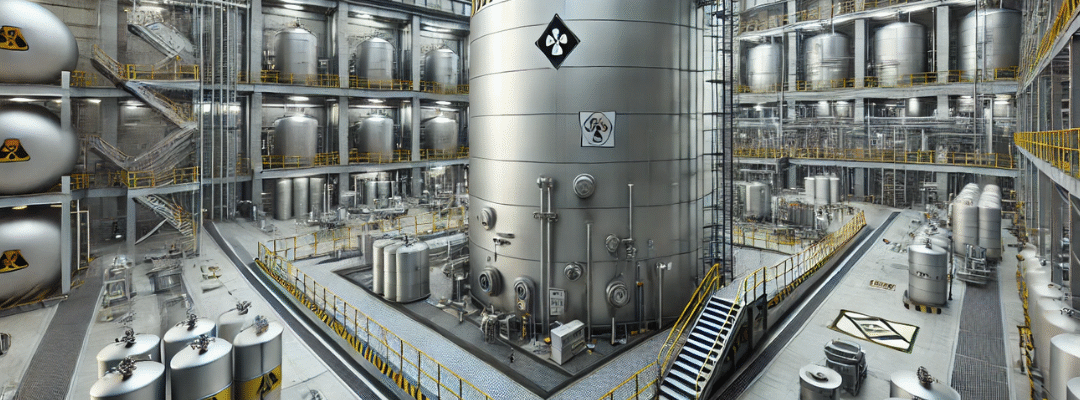Storing chemicals safely and efficiently requires careful planning. The design of a chemical storage tank must account for the properties of the stored substance, environmental risks, compliance regulations, and long-term operational safety.
Here are the most important considerations when designing a chemical storage tank:
1.Understand the Chemical Characteristics
- Chemical Nature: Identify if the chemical is acidic, alkaline, oxidizing, flammable, volatile, or toxic.
- Operating Conditions: Consider temperature sensitivity, vapor pressure, and whether the substance requires pressurized or vacuum storage.
- Compatibility: Verify chemical compatibility with tank materials and coatings to avoid corrosion, degradation, or unsafe reactions.
2.Select the Right Tank Material
- Steel (Carbon/Stainless): Suitable for many chemicals but may need internal lining for aggressive substances.
- FRP (Fiberglass Reinforced Plastic): Excellent chemical resistance, especially for corrosive liquids.
- Polyethylene/PVC: Lightweight and cost-effective for less aggressive chemicals, commonly used in modular setups.
- Rubber-Lined Tanks: Ideal for storing concentrated acids like sulfuric or hydrochloric acid.
Tip: Use chemical resistance charts from manufacturers to match tank material with the chemical being stored.
3.Determine Capacity & Allow for Expansion
- Volume Sizing: Base tank size on usage needs, replenishment cycles, and future scalability.
- Freeboard & Expansion Space: Account for thermal expansion and provide headspace to avoid spills or over-pressurization.
4.Choose the Optimal Tank Configuration
- Cylindrical Tanks: Offer even stress distribution—ideal for pressure and bulk storage.
- Vertical vs. Horizontal: Vertical tanks save space; horizontal tanks provide easy access.
- Compartmentalization: Use separate compartments or tanks when storing multiple chemicals to prevent cross-contamination.
5.Ensure Structural Integrity
- Wall Thickness & Pressure Design: Base specifications on stored chemical’s pressure and tank size.
- Environmental Loads: Design for wind, seismic activity, and extreme weather if located outdoors.
- Anchoring Systems: Secure the tank to avoid tipping or shifting during storms or earthquakes.
6.Foundation and Support Systems
- Stable Base: Use reinforced concrete or corrosion-resistant pads to support tank weight.
- Drainage and Slope: Ensure drainage away from tank base to prevent corrosion.
- Cathodic Protection: For underground or metal tanks, include corrosion protection systems.
7.Corrosion & Coating Protection
- Internal Linings: Epoxy, vinyl ester, or rubber linings help resist aggressive chemicals.
- External Coatings: UV- and weather-resistant coatings extend outdoor tank life.
- Maintenance Access: Incorporate inspection ports for routine checks on coatings and structure.
8.Temperature Control & Insulation
- Insulation Wraps: Prevent heat loss or gain for temperature-sensitive chemicals.
- Heaters or Coolers: Use trace heating or chilling jackets when storing thermally reactive liquids.
- Climate Adaptation: Design for local climate—prevent freezing or overheating.
9.Ventilation, Pressure Relief & Vapor Control
- Pressure/Vacuum Relief Valves: Prevent rupture or implosion from pressure changes.
- Breather Vents: Allow safe airflow to accommodate liquid volume changes.
- Vapor Recovery Systems: For volatile chemicals, capture vapors to reduce emissions and enhance safety.
10.Built-in Safety Systems
- Secondary Containment: Include bunds, dikes, or double-walled tanks to contain leaks.
- Overfill Prevention: Use sensors, alarms, or automated shutoff valves.
- Emergency Access: Provide hatches, fire suppression systems, and spill kits.
11.Access & Maintenance Features
- Manways: Allow safe internal inspection and cleaning.
- CIP (Clean-in-Place) Systems: Enable internal rinsing without opening the tank.
- Platforms and Railings: Ensure safe access to top-mounted equipment.
12.Agitation and Mixing Requirements
- Mechanical Mixers: Used for homogeneous chemical mixtures or when sediment prevention is needed.
- Internal Baffles: Improve mixing efficiency and reduce vortex formation.
13.Piping, Valves & Backflow Prevention
- Corrosion-Resistant Piping: Use compatible materials like PVC, CPVC, stainless steel, or PTFE-lined components.
- Valve Positioning: Locate valves for easy shutoff and emergency isolation.
- Backflow Preventers: Prevent cross-contamination between storage tanks and pipelines.
14.Regulatory & Environmental Compliance
- Fire Safety: For flammable substances, comply with NFPA, OSHA, and local fire codes. Include grounding, bonding, and explosion-proof components.
- Environmental Protection: Follow EPA/SPCC guidelines for spill prevention, containment, and control.
- Permitting: Secure required local or national permits for hazardous chemical storage.
15.Automation, Monitoring & Leak Detection
- Smart Sensors: Monitor level, temperature, pressure, and leak indicators.
- SCADA Integration: Automate control of chemical dosing, agitation, and safety protocols.
- Leak Detection Systems: Essential for underground tanks or high-risk chemicals.
16.Vapor and Emission Control
- Emission Filters: Use scrubbers or activated carbon filters to capture harmful vapors.
- Compliance with Air Quality Regulations: Required for VOC-emitting or hazardous substances.
17.Longevity and Lifecycle Planning
- Service Life: Choose materials designed for 10–30 years of performance, depending on chemical and usage.
- Inspection Schedules: Incorporate design features that support periodic visual and ultrasonic inspections.
- Modular Design: Where feasible, allow for component replacement rather than total tank decommissioning.

